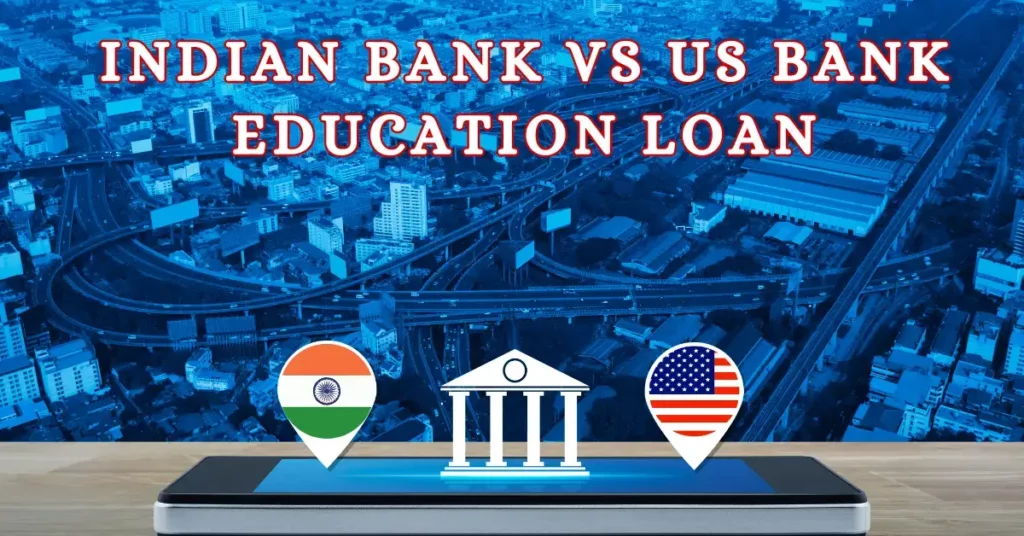
Table of Contents
- What are Indian Bank Education Loans?
- Types of Financial Lenders in India
- What are US Bank Education Loans?
- Point of Comparison: Indian vs US Bank Education Loan
- How to Choose Between Indian vs USA Education Loan
- End Note
- Frequently asked questions
The growing number of Indian students seeking quality education abroad, particularly in the US, has resulted in a surge of lending institutions offering financial assistance.
In addition to public and Private Banks and Non-Banking Financial Companies (NBFCs) in India, students can also obtain student loans from international lenders. However, borrowing from these lenders comes with its own set of conditions, each with advantages and disadvantages.
What are Indian Bank Education Loans?
Financial Education is an Indian Bank intended to assist students in pursuing higher learning locally or internationally. This includes tuition fees and support for housing, and books, among other things. It is offered by both private sector lenders like NBFCs and those in the government sector.
Types of Financial Lenders in India
Education loans in India are primarily offered by four main categories of providers:
- Government/Public Banks: The government operates these banks and offers education loans with competitive interest rates and favorable terms. For Study Abroad Aspirants, these loans are generally collateral loans.
- Private Banks: Private banks offer a range of education loan options, often with more flexible terms but potentially higher interest rates than public banks.
- Non-Banking Financial Companies (NBFCs): NBFCs offer specialized financial products, including education loans, catering to specific needs and often providing faster processing times.
- International Lenders: These lenders cater to students planning to study abroad, offering loans in foreign currencies tailored to international education’s financial requirements.
What are US Bank Education Loans?
The primary purpose of US Bank Education Loans, or private student loans, is to assist individuals from the United States who want to pay for higher education. They are given out by various private lenders, which include credit unions and banks, among other financial institutions, to cater to different types of academic costs, like tuition fees and house accommodation.
Point of Comparison: Indian vs US Bank Education Loan
| Comparison | USA Banks | Indian Banks |
| Type of Loan | Education loans in the USA are non-collateral and are called private student loans. The loans have variable returns on investment. | All private and public sector banks and NBFCs provide overseas education loans to Indian citizens. These loans are called Education Loans. |
| Need for Co-signer | Education loans in the USA require a co-signer to be a U.S. citizen or green card holder with a good credit history and at least two years of residency. | Banks and NBFCs in India do not necessarily demand a US co-signer. Overseas education loans can be obtained with an Indian co-signer through lenders like Avanse and Credila. |
| Rate of Interest | In the USA, the interest rate on education loans usually ranges from 4.1% onwards in USD. | The rate of interest for public banks ranges between 9.5% – 10%, while that of private banks and NBFCs is 10.5% – 13.5% |
| Loan Amount | You can get a loan up to the I-20 value for US education loans. The loan is generally for a period of 1 year, requiring a new application for subsequent years. | Students looking for foreign education loans can get loans limited by 80% – 100% of collateral or up to the maximum cost of study. |
| Repayment tenure | Upto 15 years. | Upto 15 years from all lenders. |
| Processing Fees (Chargeable & Upfront Charges) | Public sector banks: INR 10,000 + GST (Refundable/Non-Refundable).Private Banks and NBFCs: 1%+ GST included in the loan amount. | Public sector banks: INR 10,000 + GST (Refundable/Non-Refundable).Private Banks and NBFCs: 1%+ GST included of the loan amount. |
| 80 E Tax Benefit | Not applicable for education loans in the USA. | 80(E) applies only to a few lenders for others, they can claim a deduction under 80(C) |
How to Choose Between Indian vs USA Education Loan?
It’s essential to conduct thorough research and compare multiple lenders to secure the best loan amount and terms. When evaluating options, consider the following loan features:
- Loan Amount: Ensure the loan covers all necessary expenses, including tuition, accommodation, and other fees.
- Interest Rate: Opt for a lower interest rate to minimize overall interest charges.
- Interest Rate Type: Decide between a fixed rate, which remains constant, or a variable rate, which may increase over time.
- Repayment Period and Terms: Understand the duration and terms for repaying the loan.
- Associated Fees: Be aware of additional costs such as application, origination, or disbursement fees that can increase your borrowing costs.
- Annual Percentage Rate (APR): Compare the APR, which includes interest and fees, to get a clear picture.
- Timing and Method of Funds Disbursement: Confirm that the loan options will be disbursed in time to meet your tuition deadlines and check whether the funds go directly to your financial aid office or you.
End Note:
Education loans may be daunting, but you need not go it alone. With our expert counselors, we are ready to give you custom-made guidance that will lead you to suitable options for taking out loans that correspond with your specific needs. Whether you want to go overseas for further studies in a specific university or need financial guidance, we are ready.
Book a No Cost Consultation Today!
Frequently asked questions:
What is the primary difference between Indian and US bank education loans?
- Indian Banks: These loans typically require collateral for larger amounts, and interest rates can vary between public and private banks.
- US Banks: These loans are often unsecured and may require a US co-signer. They generally offer lower interest rates compared to Indian banks.
What types of collateral are accepted by Indian banks for education loans?
Banks in India accept different securities like immovable property- house and land, fixed deposit, life insurance policies, shares and securities, mutual funds, and government securities.
Do US banks require collateral for education loans?
No, US banks generally do not require collateral for education loans. Instead, they often require a co-signer who is a US citizen or a permanent resident with a good credit history.
Can I apply for an education loan from a US bank as an Indian student?
Yes, but you will need a US co-signer (a citizen or permanent resident) who meets the lender’s credit requirements.
Are there any tax benefits for education loans taken from Indian and US banks?
- Under Section 80E of the Income Tax Act, Indian Banks stated that borrowers can claim a tax deduction on the interest paid on education loans.
- US Banks do not offer tax benefits for Indian students who take out education loans from them.

